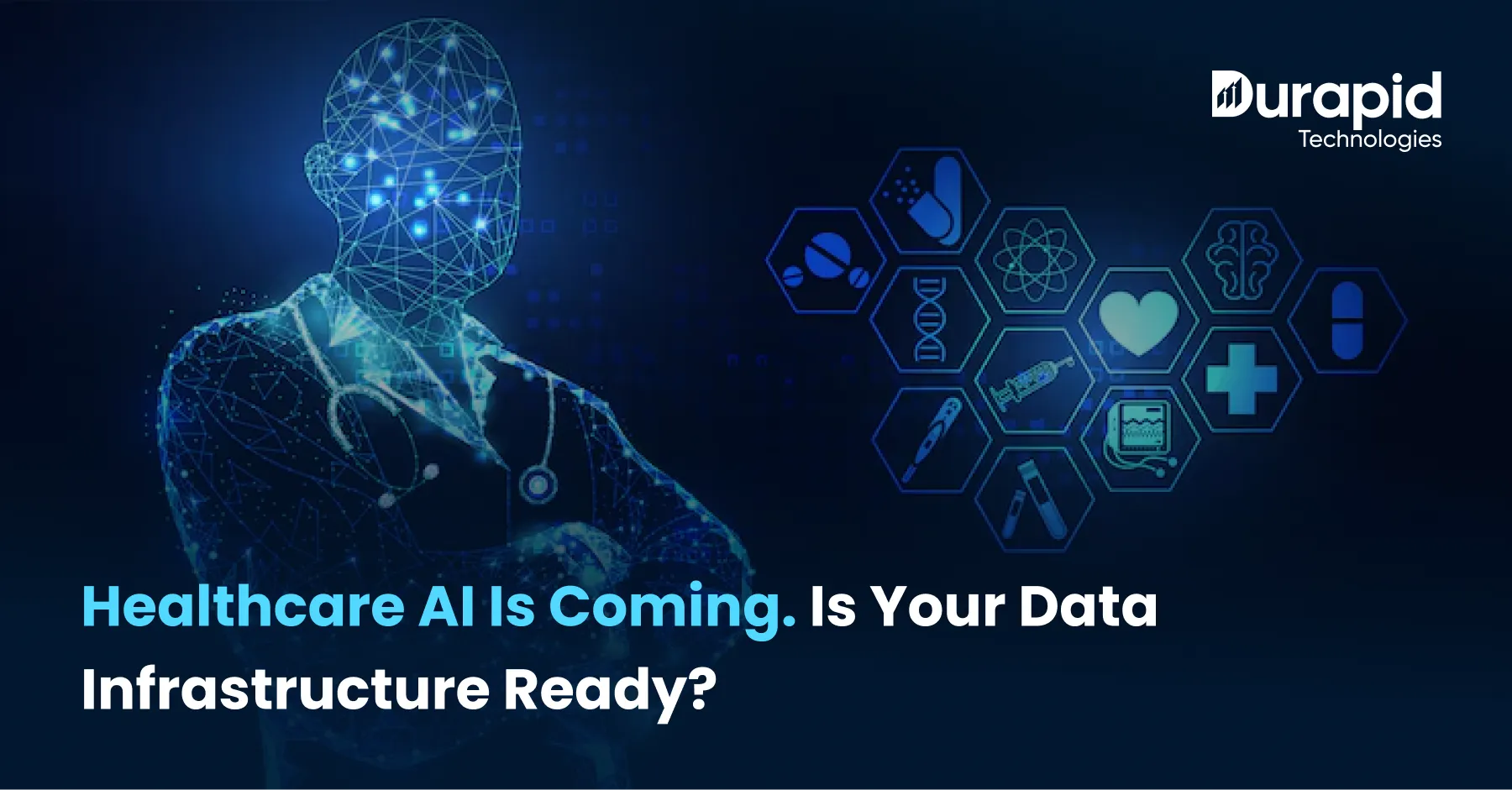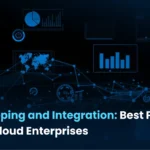Healthcare AI Is Coming. Is Your Data Infrastructure Ready?

AI is no longer a futuristic add-on in healthcare, it’s fast becoming a critical part of diagnostics, treatment planning, operations, and patient experience.
From generative AI in healthcare reshaping radiology workflows to predictive analytics improving ICU outcomes, the potential is massive.
But here’s the hard truth:
Most healthcare organizations aren’t asking the right question:
Is our healthcare data infrastructure ready for AI at all?
The Readiness Gap No One Talks About
According to recent industry reports:
- 83% of healthcare leaders say they’ll implement some form of AI in the next 3 years.
- Yet only 31% feel their current data infrastructure is capable of supporting that shift.
This gap isn’t just about tech upgrades.
It’s about organizational preparedness, regulatory compliance in healthcare, and long-term scalability.
Done right, modernizing your data backbone isn’t just a necessity.
It becomes your competitive edge.
What the Current Data Landscape Looks Like
Let’s look at how most healthcare data systems are structured today:
- Fragmented sources: EHRs, medical imaging, lab systems, and wearables all produce data, but rarely speak to each other.
- Non-standard formats: Lack of FHIR, DICOM, and HL7 adoption leads to poor interoperability.
- Unstructured data: Clinical notes, voice inputs, scanned prescriptions, difficult for AI models to process without preprocessing layers.
- Limited governance: Without strong master data governance, the risk of bias and error in AI outputs increases dramatically.
In other words, these systems were built for storage and compliance, not for real-time insights or AI-driven patient insights.
What an AI-Ready Data Infrastructure Really Requires
If your organization is serious about healthcare AI implementation, here’s what your backend should actually look like:

1. Computational Power
- Support for GPU-accelerated clusters
- Minimum: 10–100 teraflops processing power for real-time AI model execution
2. High-Speed Storage
- Systems capable of delivering 10 GB/s throughput
- Critical for large-scale imaging and genomics-based diagnostics
3. Low-Latency Networks
- Sub-10ms performance required for AI-assisted diagnostics and remote patient monitoring
4. Standardized Data Formats
- Support for FHIR R4, DICOM 3.0, and HL7
- Essential for interoperability across platforms and vendors
5. Scalability & Flexibility
- Auto-scaling cloud or hybrid infrastructure
- Able to handle 10x data spikes, especially during public health emergencies
Key Components of AI-Ready Healthcare Data Systems
1. Master Data Governance Framework
Strong master data governance is non-negotiable when preparing your healthcare data infrastructure for AI. Without unified standards and ownership, even the most powerful AI systems fail to deliver accurate insights.
What it means in practice:
- Define data stewardship roles for clarity in ownership and accountability
- Deploy automated quality checks that trigger real-time alerts when issues arise
- Use version control to track every schema update and minimize confusion
- Maintain compliance-friendly audit trails to support HIPAA, GDPR, and other regulations
Why it matters:
Poor data = poor insights. Governance ensures AI-driven patient insights are built on a consistent, trustworthy foundation.
2. Cloud-Native Architecture for Scalable Healthcare Analytics
Modern healthcare AI implementation demands cloud-native infrastructure. Static systems can’t handle the volume, variety, or velocity of healthcare data required for AI.
What your stack should include:
- Container orchestration via Kubernetes with built-in healthcare-grade security
- Microservices-based APIs for modular, flexible integration of AI tools
- Data lakes that accommodate both structured EMR data and unstructured clinical notes
- Real-time pipelines powered by Kafka or AWS Kinesis for continuous patient monitoring
Why it matters:
With healthcare cloud data analytics, you unlock scalable AI deployment and seamless integration across care touchpoints.
3. Advanced Security and Regulatory Compliance
As generative AI in healthcare evolves, so do the risks. Every layer of your data infrastructure modernization must be secure and compliant, end-to-end.
Build a secure foundation using:
- AES-256 and TLS 1.3 encryption for complete data protection in transit and at rest
- Zero-trust access enforced through MFA and role-based controls
- Network segmentation to isolate AI workflows and minimize breach impact
- Automated compliance tools for real-time violation detection and audits
Why it matters:
Without robust data security in healthcare information systems, even the best AI models can’t be trusted, or legally deployed.
Healthcare AI Implementation: Challenges and Practical Solutions
A. Tackling Data Silos with Interoperability
Data silos kill AI performance. Most healthcare orgs juggle multiple systems with no shared language.
How to fix it:
- Implement FHIR-compliant APIs to ensure seamless system communication
- Use interoperability-focused integration platforms that respect data integrity
- Standardize formats early using master data governance protocols
Outcome: Unified, AI-ready data streams that feed reliable insights.
B. Real-Time Data for High-Stakes Applications
AI-powered decisions often depend on split-second data.
What you’ll need:
- Stream processors like Apache Storm or Spark Streaming for immediate computation
- In-memory databases (e.g., Redis) for ultra-fast data access
- Edge computing on IoT medical devices for bedside decisions
- High-throughput API gateways that support thousands of requests per second
Use cases:
- Emergency response coordination
- ICU patient monitoring
- AI-assisted diagnostics
How to Prepare Healthcare Data Infrastructure for AI
Step 1: Conduct a Ground-Level Assessment
Start with clarity. Know your current gaps before modernizing.
Evaluate:
- Storage capacity and growth potential
- Network strength (bandwidth, latency)
- Security vulnerabilities
- Regulatory compliance posture
- Staff readiness and training gaps
This lays the groundwork for an actionable plan.
Step 2: Execute a Phased Modernization Strategy
AI readiness isn’t achieved overnight. Move in smart, manageable phases:
Phase 1: Foundation (Months 1–6)
- Define and document governance policies
- Standardize data formats and API specs
- Upgrade network infrastructure
- Lock down baseline security protocols
Phase 2: Platform Building (Months 6–12)
- Migrate to cloud-native analytics platforms
- Enable real-time processing pipelines
- Set up AI development sandboxes
- Deploy a flexible data lake architecture
Phase 3: AI Activation (Months 12–18)
- Roll out pilot AI applications
- Introduce advanced analytics and dashboards
- Monitor, optimize, and scale successful models
- Regularly audit with a healthcare data infrastructure readiness checklist
Best Practices for AI-Ready Healthcare Data Systems
Modern healthcare isn’t just about adopting AI, it’s about preparing the data infrastructure to actually support it.
Without a strong foundation, AI efforts will stall. Here’s what leading organizations are doing to build AI-ready healthcare data infrastructure that’s scalable, secure, and future-proof.
1. Adopt a Cloud-First, Not Cloud-Eventually Strategy
Moving to the cloud isn’t just an IT decision anymore, it’s a strategic one.
Here’s why cloud-first is becoming the default for healthcare AI implementation:
- Scalability for handling massive health data volumes and AI workloads
- Access to AI/ML services, pre-trained models, and accelerators
- Native tools for healthcare cloud data analytics
- Support for regulatory compliance in healthcare through HIPAA, HITRUST, and other certifications
When evaluating providers, go beyond pricing. Look at:
- Data residency and sovereignty policies
- Healthcare-specific security features
- Integration with existing EHRs and PACS
2. Set Up Continuous Data Quality Monitoring
AI doesn’t just “work” with any data. It needs:
- Clean
- Complete
- Consistent
Information, on loop.
Here’s what to prioritize:
- Real-time data validation across systems
- Automated alerts for data anomalies
- Completeness checks and reconciliation between sources
- Cross-format compatibility
In short: Poor-quality data → flawed AI output → clinical and operational risks.
This is where master data governance becomes critical.
3. Create Cross-Functional, Not Siloed, AI Teams
AI in healthcare isn’t a job for the tech team alone.
Form cross-functional teams that include:
- IT and data engineers
- Clinical leaders and physicians
- Compliance and legal experts
- Operations and finance stakeholders
This alignment ensures:
- AI models reflect real clinical workflows
- Patient privacy is baked into system design
- Teams co-own success, from pilots to production
A strong team leads to faster, smoother healthcare AI implementation, with fewer surprises down the road.
4. Engineer for Regulatory Compliance from Day 1
AI in healthcare = stricter scrutiny.
Your healthcare data infrastructure must support:
- Full audit trails of AI-driven decisions
- Algorithm explainability and traceability
- Role-based access and identity management
- Patient consent management workflows
Expect data regulators to demand more transparency as generative AI in healthcare becomes mainstream.
Healthcare Data Infrastructure Readiness Checklist
Think your system is AI-ready? Run it through this checklist first.

Data Management
- Standardized data formats across departments and systems
- Real-time data flow and synchronization
- Backup, restore, and disaster recovery protocols
- Data lineage and version control
Technical Infrastructure
- High-performance compute nodes (GPU/TPU clusters)
- Scalable storage (cloud-native and hybrid models)
- Low-latency, high-bandwidth connectivity
- Containerized environments and orchestration (Kubernetes, Docker)
Security and Compliance
- End-to-end encryption (in transit and at rest)
- Role-based access controls with MFA
- Regular security audits, penetration testing
- Monitoring for suspicious activity and data breaches
Operational Readiness
- Staff trained on AI and data governance
- Established AI change management processes
- Performance metrics and optimization loops
- Clear SLAs with AI service vendors
This isn’t just a checklist. It’s your healthcare data infrastructure readiness checklist for avoiding downstream AI deployment issues.
The Future of AI-Driven Healthcare
What’s coming next? Generative AI in healthcare is just getting started.
Expect to see:
- Hyper-personalized treatment plans powered by AI-driven patient insights
- Faster clinical trials through synthetic data and simulation
- Real-time diagnosis support in radiology and pathology
- Population health analytics with predictive capabilities at scale
But none of it works without:
- Clean, secure, and interoperable data
- Ongoing data infrastructure modernization
- Full commitment to regulatory compliance in healthcare
Investing in your data systems today means staying relevant tomorrow.
Because in the world of AI-driven healthcare, infrastructure isn’t just the backend, it’s the backbone.
Is Your Healthcare Data Infrastructure Ready for the AI Leap?
The question is no longer if AI will impact healthcare, but how well prepared your organization is to embrace it.
AI in healthcare isn’t just about advanced tools and algorithms, it’s about the foundation those tools depend on. And that foundation is your healthcare data infrastructure.
Without the right infrastructure in place, even the most sophisticated AI models can fall flat. Think unreliable patient insights, security gaps, and compliance risks. On the other hand, organizations that modernize their data systems now will:
- Enable faster, more accurate AI-driven patient insights
- Enhance data quality through master data governance
- Strengthen data security in healthcare information systems
- Meet evolving regulatory compliance requirements with confidence
- Seamlessly adopt generative AI in healthcare workflows
What Does It Take to Be AI-Ready?
Building a future-ready infrastructure isn’t a one-time project. It’s a strategic, organization-wide shift involving:
- Data infrastructure modernization tailored to clinical, operational, and analytical needs
- A clear healthcare data infrastructure readiness checklist to identify current gaps
- Scalable systems that support healthcare cloud data analytics
- A roadmap grounded in best practices for AI-ready healthcare data systems
Make the Shift Today
Still relying on legacy systems? They’re likely slowing you down. Here’s how you can move forward:
- Book a free infrastructure assessment to evaluate your AI readiness
Connect with our experts for a customized modernization roadmap
Let’s reimagine what healthcare can look like, with the right data systems at its core.
The future of AI in healthcare is here. Your infrastructure should be too.





